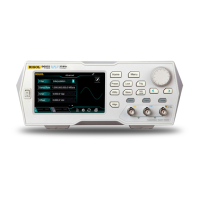RIGOL Chapter 2 Command System
2-12 DG800 Programming Guide
frequency coupling mode and frequency deviation/ratio after the frequency coupling function is
enabled.
When the frequency coupling function is disabled, if the current frequency coupling mode is frequency
deviation, sending this command can set the frequency deviation; if the current frequency coupling
mode is frequency ratio, sending this command can set the frequency coupling mode to frequency
deviation and set the frequency deviation.
You can also send the
[:SOURce[<n>]]:FREQuency:COUPle:OFFSet command to set and query the
frequency deviation in the frequency coupling.
Return Format
The query returns the frequency deviation in scientific notation. The returned value contains 7 effective
digits, for example, 1.000000E+02 (the frequency deviation is 100 Hz).
Example
:COUP1:FREQ:DEV 100 /*Set the frequency deviation in the frequency coupling of CH1 to 100 Hz.*/
:COUP1:FREQ:DEV? /*Queries the frequency deviation in the frequency coupling of CH1 and the
query returns 1.000000E+02.*/
:COUPling[<n>]:FREQuency:MODE
Syntax
:COUPling[<n>]:FREQuency:MODE {OFFSet|RATio}
:COUPling[<n>]:FREQuency:MODE?
Description
Sets the frequency coupling mode to frequency deviation (OFFSet) or frequency ratio (RATio).
Queries the selected frequency coupling mode of the specified channel.
Parameter
Remarks
When [<n>] is omitted, the commands set and query the related parameters of CH1 by default.
Frequency deviation mode: the frequencies of CH1 and CH2 have a certain deviation relation. The
parameter relations are F
CH2
=F
CH1
+F
Dev
(the reference source is CH1); F
CH1
=F
CH2
-F
Dev
(the reference
source is CH2). Wherein, F
CH1
is the frequency of CH1, F
CH2
is the frequency of CH2, and F
Dev
is the
frequency deviation.
Frequency ratio mode: the frequencies of CH1 and CH2 have a certain ratio relation. The parameter
relations are F
CH2
=F
CH1
*F
Ratio
(the reference source is CH1); F
CH1
=F
CH2
/F
Ratio
(the reference source is
CH2). Wherein, F
CH1
is the frequency of CH1, F
CH2
is the frequency of CH2, and F
Ratio
is the set
frequency ratio.
If the frequency of CH1 or CH2 exceeds the frequency upper limit or lower limit of the channel after the
channel coupling, the instrument will automatically adjust the frequency upper limit or lower limit of
the other channel to avoid parameter over-range.
Select the desired frequency coupling mode and set the corresponding frequency deviation
(
:COUPling[<n>]:FREQuency:DEViation) or frequency ratio (:COUPling[<n>]:FREQuency:RATio)
before enabling the frequency coupling function (
:COUPling[<n>]:FREQuency[:STATe]). You cannot
set the frequency coupling mode and frequency deviation/ratio after the frequency coupling function is
enabled.
You can also send the
[:SOURce[<n>]]:FREQuency:COUPle:MODE command to set and query the
frequency coupling mode of the specified channel.
Return Format
The query returns OFFS or RAT.

